They developed the world’s most powerful battery
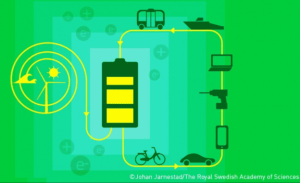
The Nobel Prize in Chemistry 2019 is awarded to John B. Goodenough, M. Stanley Whittingham and Akira Yoshino for their contributions to the development of the lithium-ion battery. This rechargeable battery laid the foundation of wireless electronics such as mobile phones and laptops. It also makes a fossil fuel-free world possible, as it is used for everything from powering electric cars to storing energy from renewable sources.
An element rarely gets to play a central role in a drama, but the story of 2019’s Nobel Prize in Chemistry has a clear protagonist: lithium, an ancient element that was created during the first minutes of the Big Bang. Humankind became aware of it in 1817, when Swedish chemists Johan August Arfwedson and Jöns Jacob Berzelius purified it out of a mineral sample from Utö Mine, in the Stockholm archipelago.
Berzelius named the new element after the Greek word for stone, lithos. Despite its heavy name, it is the lightest solid element, which is why we hardly notice the mobile phones we now carry around.
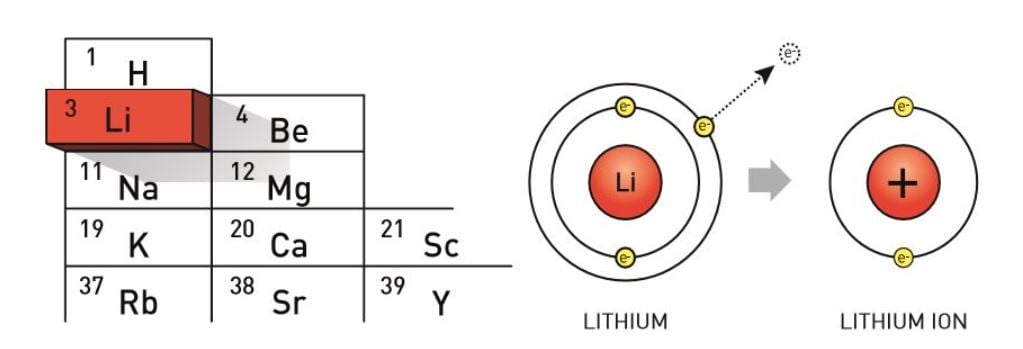
Lithium is a metal. It has just one electron in its outer electron shell, and this has a strong drive to leave lithium for another atom. When this happens, a positively charged – and more stable – lithium ion is formed.
To be completely correct – the Swedish chemists did not actually find pure metallic lithium, but lithium ions in the form of a salt. Pure lithium has set off many fire alarms, not least in the story we will tell here; it is an unstable element that must be stored in oil so it does not react with air.
Lithium’s weakness – its reactivity – is also its strength. In the early 1970s, Stanley Whittingham used lithium’s enormous drive to release its outer electron when he developed the first functional lithium battery. In 1980, John Goodenough doubled the battery’s potential, creating the right conditions for a vastly more powerful and useful battery. In 1985, Akira Yoshino succeeded in eliminating pure lithium from the battery, instead basing it wholly on lithium ions, which are safer than pure lithium. This made the battery workable in practice. Lithium-ion batteries have brought the greatest benefit to humankind, as they have enabled the development of laptop computers, mobile phones, electric vehicles and the storage of energy generated by solar and wind power.
We will now step fifty years back in time, to the beginning of the lithium-ion battery’s highly charged story.
Petrol haze revitalises battery research
In the mid-20th century, the number of petrol-driven cars in the world increased significantly, and their exhaust fumes worsened the harmful smog found in big cities. This, combined with the growing realisation that oil is a finite resource, sounded an alarm for both vehicle manufacturers and oil companies. They needed to invest in electric vehicles and alternative sources of energy if their businesses were to survive.
Electric vehicles and alternative sources of energy both require powerful batteries that can store large amounts of energy. There were really only two types of rechargeable batteries on the market at this time: the heavy lead battery that had been in invented back in 1859 (and which is still used as a starter battery in petrol-driven cars) and the nickel-cadmium battery that was developed in the first half of the 20th century.
Oil companies invest in new technology
The threat of oil running out resulted in an oil giant, Exxon, deciding to diversify its activities. In a major investment in basic research they recruited some of that time’s foremost researchers in the field of energy, giving them the freedom to do pretty much what they wanted as long as it did not involve petroleum.
Stanley Whittingham was among those who moved to Exxon in 1972. He came from Stanford University, where his research had included solid materials with atom-sized spaces in which charged ions can attach. This phenomenon is called intercalation. The materials’ properties change when ions are caught inside them. At Exxon, Stanley Whittingham and his colleagues started to investigate superconducting materials, including tantalum disulphide, which can intercalate ions. They added ions to tantalum disulphide and studied how its conductivity was affected.
Whittingham discovers an extremely energy-dense material
As is so often the case in science, this experiment led to an unexpected and valuable discovery. It turned out that potassium ions affected the conductivity of tantalum disulphide, and when Stanley Whittingham started to study the material in detail he observed that it had a very high energy density. The interactions that arose between the potassium ions and the tantalum disulphide were surprisingly energy rich and, when he measured the material’s voltage, it was a couple of volts. This was better than many of that time’s batteries. Stanley Whittingham quickly realised that it was time to change track, moving to the development of new technology that could store energy for the electric vehicles of the future. However, tantalum is one of the heavier elements and the market did not need to be laden with more heavy batteries – so he replaced tantalum with titanium, an element which has similar properties but is much lighter.
Lithium in the negative electrode
Isn’t lithium supposed to have pride of place in this story? Well, this is where lithium enters the narrative – as the negative electrode on Stanley Whittingham’s innovative battery. Lithium was not a random choice; in a battery, electrons should flow from the negative electrode – the anode – to the positive one – the cathode. Therefore, the anode should contain a material that easily gives up its electrons and, of all the elements, lithium is the one that most willingly releases electrons.
The result was a rechargeable lithium battery that worked at room temperature and – literally – had great potential. Stanley Whittingham travelled to Exxon’s headquarters in New York to talk about the project. The meeting lasted about fifteen minutes, with the management group subsequently making a rapid decision: they would develop a commercially viable battery using Whittingham’s discovery.
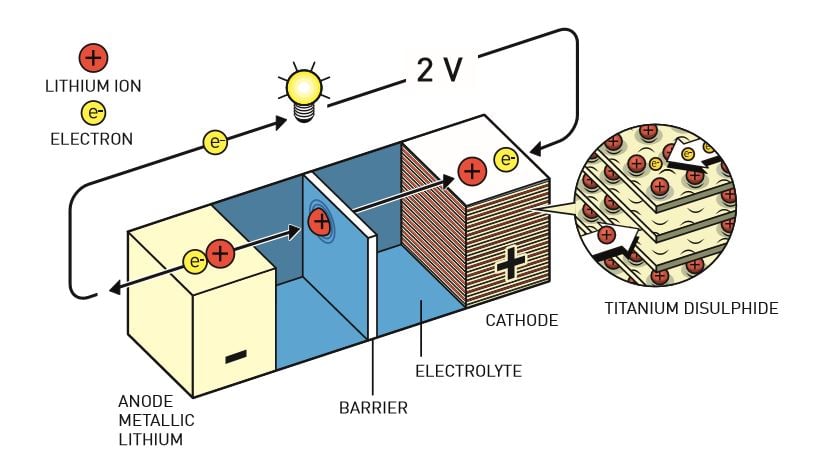
The first rechargeable batteries had solid materials in the electrodes, which broke down when they reacted chemically with the electrolyte. This destroyed the batteries. The advantage of Whittingham’s lithium battery was that lithium ions were stored in spaces in the titanium disulphide in the cathode. When the battery was used, lithium ions flowed from the lithium in the anode to the titanium disulphide in the cathode. When the battery was charged, the lithium ions flowed back again.
The battery explodes and the oil price falls
Unfortunately, the group that was to start producing the battery suffered some setbacks. As the new lithium battery was repeatedly charged, thin whiskers of lithium grew from the lithium electrode. When they reached the other electrode, the battery short-circuited which could lead to an explosion. The fire brigade had to put out a number of fires and finally threatened to make the laboratory pay for the special chemicals used to extinguish lithium fires.
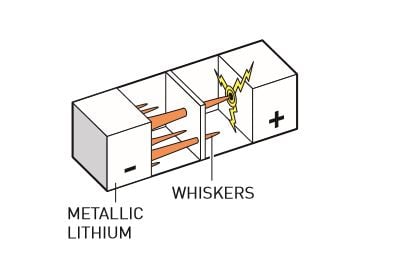
Whiskers of lithium form when a battery with pure lithium in the anode is charged. These can short-circuit the battery and cause fires and even explosions.
To make the battery safer, aluminium was added to the metallic lithium electrode and the electrolyte between the electrodes was changed. Stanley Whittingham announced his discovery in 1976 and the battery began to be produced on a small scale for a Swiss clockmaker that wanted to use it in solar-powered timepieces.
The next objective was to scale up the rechargeable lithium battery so it could power a car. However, the price of oil fell dramatically in the early 1980s and Exxon needed to make cutbacks. The development work was discontinued and Whittingham’s battery technology was licenced to three different companies in three different parts of the world.
However, this did not mean that development stopped. When Exxon gave up, John Goodenough took over.
The oil crisis makes Goodenough interested in batteries
As a child, John Goodenough had significant problems learning to read, which was one reason why he was drawn to mathematics and eventually – after World War Two – also physics. He worked for many years at the Lincoln Laboratory at the Massachusetts Institute of Technology, MIT. While there, he contributed to the development of random access memory (RAM) which is still a fundamental component of computing.
John Goodenough, like so many other people in the 1970s, was affected by the oil crisis and wanted to contribute to the development of alternative sources of energy. However, the Lincoln Laboratory was funded by the US Air Force and did not permit all kinds of research, so when he was offered a position as professor of inorganic chemistry at Oxford University in Great Britain, he took the chance and entered the important world of energy research.
High voltages when lithium ions hide in cobalt oxide
John Goodenough knew about Whittingham’s revolutionary battery, but his specialised knowledge of matter’s interior told him that its cathode could have a higher potential if it was built using a metal oxide instead of a metal sulphide. A few people in his research group were then tasked with finding a metal oxide that produced a high voltage when it intercalated lithium ions, but which did not collapse when the ions were removed.
This systematic search was more successful than John Goodenough had dared to hope. Whittingham’s battery generated more than two volts, but Goodenough discovered that the battery with lithiumcobalt oxide in the cathode was almost twice as powerful, at four volts.
One key to this success was John Goodenough’s realisation that batteries did not have to be manufactured in their charged state, as had been done previously. Instead, they could be charged afterwards. In 1980, he published the discovery of this new, energy-dense cathode material which, despite its low weight, resulted in powerful, high-capacity batteries. This was a decisive step towards the wireless revolution.
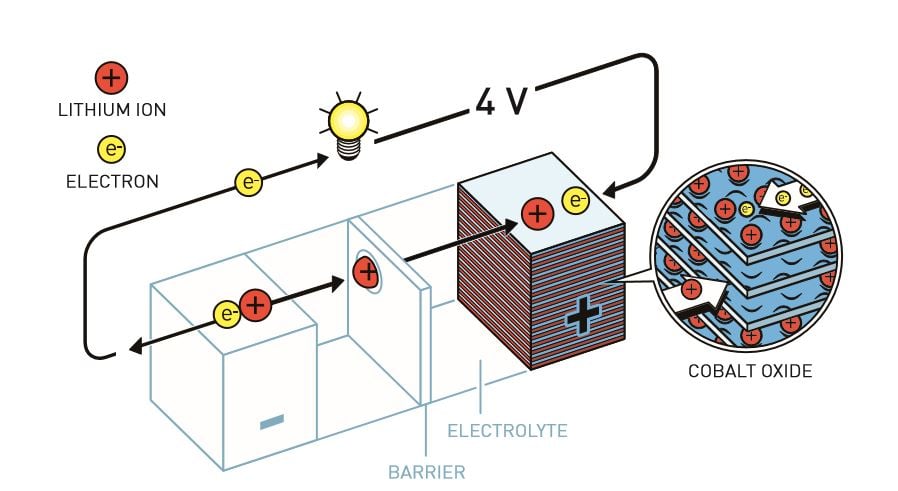
Goodenough started to use cobalt oxide in the lithium battery’s cathode. This almost doubled the battery’s potential and made it much more powerful.
Japanese companies want lightweight batteries for new electronics
However, in the West, as oil became cheaper, interest paled in investments in alternative energy technology and the development of electric vehicles. Things were different in Japan; electronics companies were desperate for lightweight, rechargeable batteries that could power innovative electronics, such as video cameras, cordless telephones and computers. One person who saw this need was Akira Yoshino from the Asahi Kasei Corporation. Or as he put it: “I just sort of sniffed out the direction that trends were moving. You could say I had a good sense of smell.”
Yoshino builds the first commercially viable lithium-ion battery
When Akira Yoshino decided to develop a functional rechargeable battery, he had Goodenough’s lithium-cobalt oxide as the cathode and tried using various carbon-based materials as the anode. Researchers had previously shown that lithium ions could be intercalated in the molecular layers in graphite, but the graphite was broken down by the battery’s electrolyte. Akira Yoshino’s eureka moment came when he instead tried using petroleum coke, a by-product of the oil industry. When he charged the petroleum coke with electrons, the lithium ions were drawn into the material. Then, when he turned on the battery, the electrons and lithium ions flowed towards the cobalt oxide in the cathode, which has a much higher potential.
The battery developed by Akira Yoshino is stable, lightweight, has a high capacity and produces a remarkable four volts. The greatest advantage of the lithium-ion battery is that the ions are intercalated in the electrodes. Most other batteries are based on chemical reactions in which the electrodes are slowly but surely changed. When a lithium-ion battery is charged or used, the ions flow between the electrodes without reacting with their surroundings. This means the battery has a long life and can be charged hundreds of times before its performance deteriorates.
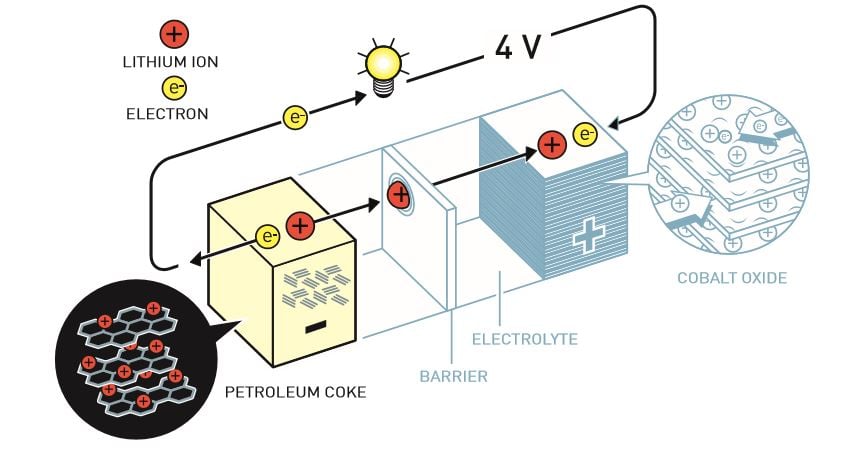
Akira Yoshino developed the first commercially viable lithium-ion battery. He used Goodenough’s lithium-cobalt oxide in the cathode and in the anode he used a carbon material, petroleum coke, which can also intercalate lithium ions. The battery’s functionality is not based upon any damaging chemical reactions. Instead, the lithium ions flow back and forth between the electrodes, which gives the battery a long life.
Another big advantage is that the battery has no pure lithium. In 1986, when Akira Yoshino was testing the battery’s safety, he exercised caution and used a facility designed for testing explosive devices. He dropped a large piece of iron on the battery, but nothing happened. However, on repeating the experiment with a battery that contained pure lithium, there was a violent explosion.
Passing safety testing was fundamental to the future of the battery. Akira Yoshino says that this was “the moment when the lithium-ion battery was born”.
The lithium-ion battery – necessary for a fossil fuel-free society
In 1991, a major Japanese electronics company started selling the first lithium-ion batteries, leading to a revolution in electronics. Mobile phones shrank, computers became portable and MP3 players and tablets were developed.
Subsequently, researchers around the world have searched through the periodic table on the hunt for even better batteries, but no one has yet succeeded in inventing something that beats the lithiumion battery’s high capacity and voltage. However, the lithium-ion battery has been changed and improved; among other things, John Goodenough has replaced the cobalt oxide with iron phosphate, which makes the battery more environmentally friendly.
Like almost everything else, the production of lithium-ion batteries has an impact on the environment, but there are also huge environmental benefits. The battery has enabled the development of cleaner energy technologies and electric vehicles, thus contributing to reduced emissions of greenhouse gases and particulates.
Through their work, John Goodenough, Stanley Whittingham and Akira Yoshino have created the right conditions for a wireless and fossil fuel-free society, and so brought the greatest benefit to humankind.
Source:The Nobel Prize in Chemistry 2019 – Popular information

